Stomach (Gastric) Cancer
Background
An estimated 4,200 Canadians will be diagnosed with stomach cancer annually [1]. Some risk factors for stomach cancer include smoking, having a history of helicobactor pylori infection or Epstein-Barr virus, and diets high in pickled or salted foods [1]. There is emerging evidence for occupational risk factors and stomach cancer. Occupation has been suspected to contribute to risk of developing stomach cancer with exposure to “dusty” occupations, exposure to N-nitrosamines and asbestos [2,3]. There are a number of different groups in the ODSS that show increased risks for stomach cancer.
Possible occupational exposures
-
- Asbestos [4]
- Lead compounds, inorganic [4]
- N-Nitroso compounds and nitrogen oxides [4]
- Occupational exposures in the rubber production industry [4]
- Silica [5]
Key Findings
Construction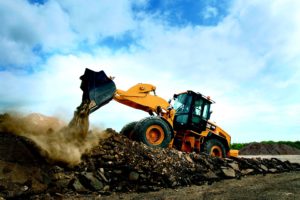
Overall, the construction industry demonstrated an increased risk of stomach cancer and some construction trades were associated with higher risks. Construction workers may be exposed to asbestos, when working in older buildings, welding fumes, wood dust, and silica dust which may increase the risk for stomach cancer [5,6].
-
- Construction industry: 1.27 times the risk
- Construction trades occupations: 1.15 times the risk
- Excavating, grading, paving, and related: 1.27 times the risk
- Other construction trades: 1.23 times the risk
- Inspecting, testing, grading, and sampling: 2.46 times the risk
- Concrete finishing and related: 1.92 times the risk
- Brick and stone masons and tile setters: 1.36 times the risk
- Painters, paperhangers, and related: 1.44 times the risk
- Foremen: 1.21 times the risk
- Labouring and other elemental work: 1.28 times the risk
Chemical manufacturing and related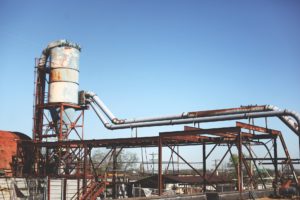
People working in chemical manufacturing were observed to be at an increased risk for stomach cancer. Some studies also saw increased risk of stomach cancer among chemical workers with possible exposure to dyes or solvents [2,7].
-
- Chemical manufacturing industries:
- Paint and varnish: 1.54 times the risk
- Soap and cleaning: 1.39 times the risk
- Toilet preparations: 1.28 times the risk
- Chemical manufacturing industries:
Electric and electronic products
Work with electric and electronic products could lead to exposure to polychlorinated biphenyls although there is no evidence relating these exposures to stomach cancer [8,9]. Electrical production work may also be associated with various metallic dusts which have been associated with increased risk of cancer [5,10]. Some suggest exposure to inorganic lead as a contributor to the increased risk of stomach cancer among electrical or electronics workers [11,12].
-
- Electrical products manufacturing industries: 1.13 times the risk
- Manufacturers of small electrical appliances: 1.45 times the risk
- Manufacturers of lighting fixtures: 2.17 times the risk
- Manufacturers of household radio and TV receivers: 1.25 times the risk
- Manufacturers of electrical industrial equipment: 1.22 times the risk
- Foremen: fabricating, assembling, installing and repairing, electrical, electronic and related equipment occupations: 1.18 times the risk
- Electronic equipment fabricating and assembling occupations: 1.18 times the risk
- Labouring and other elemental work: fabricating, assembling, installing, and repairing electrical, electronic, and related equipment occupations: 1.35 times the risk
- Foremen: electrical power, lighting, and wire communications equipment erecting, installing, and repairing occupations: 1.19 times the risk
- Electrical products manufacturing industries: 1.13 times the risk
Wood and paper products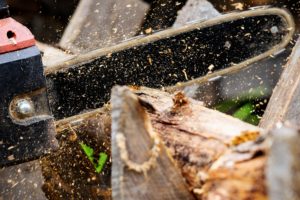
Increased risk of stomach cancer was seen across many wood-related industries and occupations in the ODSS. Workers in manufacturing and processing of wood products are exposed to wood dust, chemicals, and possibly asbestos which have been linked to increased risk of stomach cancer [13].
-
- Pulp and papermaking processing occupations: 1.35 times the risk
- Papermaking and finishing: 1.72 times the risk
- Planing, turning, shaping, and wood machining occupations: 1.24 times the risk
- Cabinet and wood furniture makers occupations: 1.21 times the risk
- Carpenters and related occupations:1.17 times the risk
- Forestry and logging occupations: 1.09 times the risk
- Pulp and papermaking processing occupations: 1.35 times the risk
Manufacturing
-
- Paper and allied industries: 1.17 times the risk
- Pulp and paper mills: 1.27 times the risk
- Paper box and bag: 1.28 times the risk
- Wooden box factories industries: 1.58 times the risk
- Paper and allied industries: 1.17 times the risk
Metal processing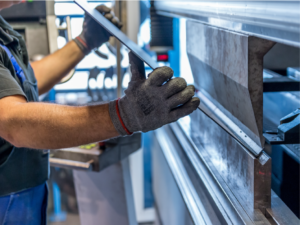
Metal processing occupations expose workers to mineral dusts and metal dusts and fumes, as well as Polycyclic aromatic hydrocarbons (PAHs).
-
- Metal processing and related occupations: 1.12 times the risk
- Foremen: metal processing and related: 1.75 times the risk
- Metal rolling: 1.25 times the risk
- Moulding, coremaking, and metal casting: 1.35 times the risk
- Plating, metal spraying and related: 1.35 times the risk
- Metal processing and related occupations: 1.12 times the risk
Food and beverage manufacturing and related
Elevated risk of stomach cancer was seen in various food-related industries and occupations. Previous studies in the literature also saw similar results although the relationship is not fully understood [5,15]. Those working in food manufacturing and processing may be exposed to organic dusts, pesticides, preserving agents [16]. For some occupations in restaurants (i.e. waiters), increases may be related to lifestyle and dietary factors [10].
-
- Food and beverage manufacturing industries: 1.09 times the risk
- Food and beverage and related processing occupations: 1.19 times the risk
- Foremen: food, beverage, and related processing: 1.13 times the risk
- Baking, confectionery making, and related: 1.07 times the risk
- Slaughtering and meat cutting, canning, curing, and packing: 1.15 times the risk
- Inspecting, testing, grading, and sampling: food, beverage, and related processing: 2.38 times the risk
- Beverage processing: 2.03 times the risk
- Labouring and other elemental work: food, beverage, and related processing: 1.29 times the risk
- Waiters, hostesses, and stewards: 1.39 times the risk
Other groups
Several other industry and occupation groups showed elevated risks of stomach cancer. Previous literature suggests that those working in rubber have a higher risk of stomach cancer [ref]. Workers in the rubber industries are exposed to dusty environments, fumes, and N-nitrosamines [17]. Workers in rubber industries had 1.13 times the risk of stomach cancer compared to all other workers in the ODSS.
Janitors and cleaners are regularly exposed to chemicals in cleaning agents. They had 1.24 times the risk of stomach cancer compared to all other workers in the ODSS. Similarly, those working in laundering or dry-cleaning occupations had 1.11 times the risk of stomach cancer. They are exposed to organic solvents which may carcinogenic but have not been associated with stomach cancer [18].
Bus drivers (HR 1.46) and subway and street railway operating occupations (HR 3.39) showed elevated risks of stomach cancer. These workers may be exposed to diesel engine exhaust, however, this exposure has not been linked to risk of stomach cancer.
Relative Risk by Industry and Occupation
Figure 1. Risk of stomach cancer diagnosis among workers employed in each industry group relative to all others, Occupational Disease Surveillance System (ODSS), 1983-2016
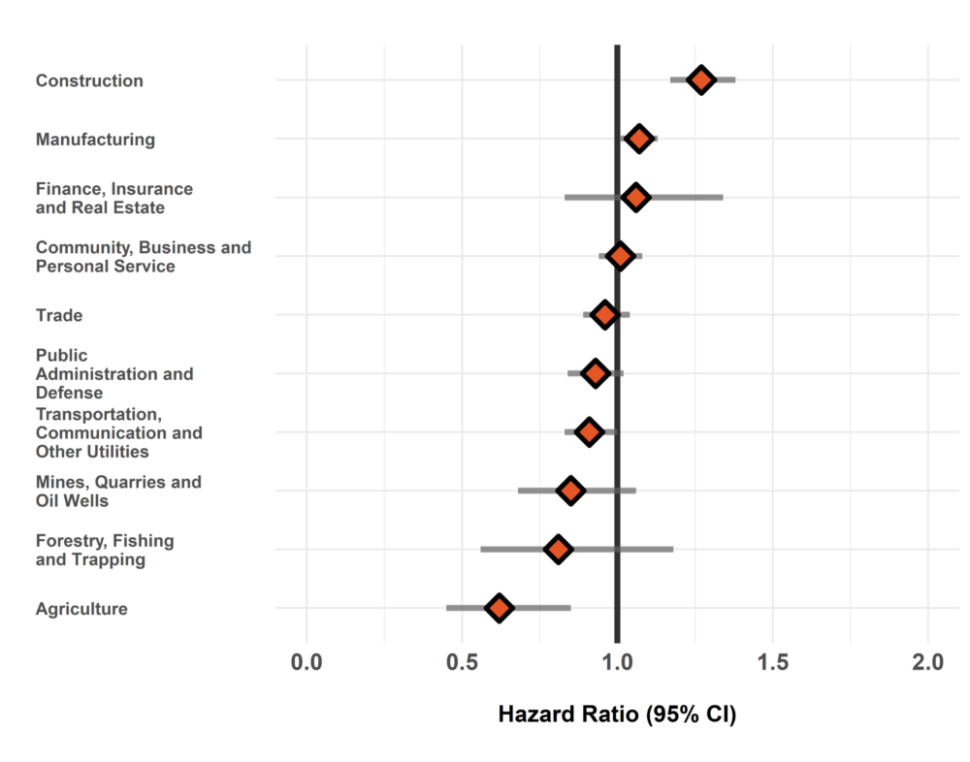
The hazard ratio is an estimate of the average time to diagnosis among workers in each industry/occupation group divided by that in all others during the study period. Hazard ratios above 1.00 indicate a greater risk of disease in a given group compared to all others. Estimates are adjusted for birth year and sex. The width of the 95% Confidence Interval (CI) is based on the number of cases in each group (more cases narrows the interval).
Figure 2. Risk of stomach cancer diagnosis among workers employed in each occupation group relative to all others, Occupational Disease Surveillance System (ODSS), 1983-2016
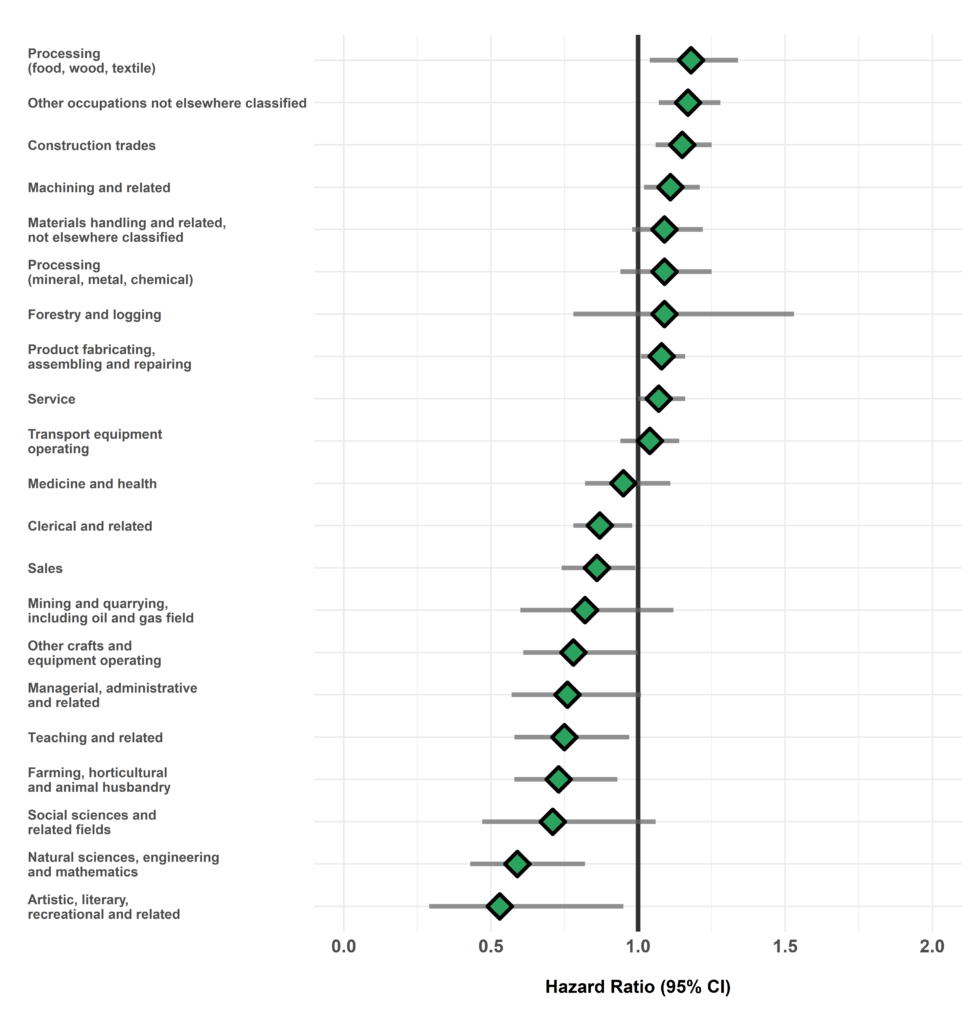
The hazard ratio is an estimate of the average time to diagnosis among workers in each industry/occupation group divided by that in all others during the study period. Hazard ratios above 1.00 indicate a greater risk of disease in a given group compared to all others. Estimates are adjusted for birth year and sex. The width of the 95% Confidence Interval (CI) is based on the number of cases in each group (more cases narrows the interval).
Table of Results
Table 1. Surveillance of Stomach Cancer: Number of cases, workers employed, and hazard ratios in each industry (SIC)
| SIC Code * | Industry Group | Number of cases | Number of workers employed | Hazard Ratio (95% CI) † |
| 1 | Agriculture | 40 | 35015 | 0.62 (0.45-0.85)** |
| 2/3 | Forestry, Fishing and Trapping |
27 | 10699 | 0.81 (0.56-1.18) |
| 4 | Mines, Quarries and Oil Wells |
78 | 23209 | 0.85 (0.68-1.06) |
| 5 | Manufacturing | 1957 | 693630 | 1.07 (1.01-1.13)* |
| 6 | Construction | 661 | 210988 | 1.27 (1.17-1.38)*** |
| 7 | Transportation, Communication and Other Utilities |
466 | 197227 | 0.91 (0.83-1.00) |
| 8 | Trade | 762 | 429300 | 0.96 (0.89-1.04) |
| 9 | Finance, Insurance and Real Estate |
69 | 23992 | 1.06 (0.83-1.34) |
| 10 | Community, Business and Personal Service |
1024 | 599658 | 1.01 (0.94-1.08) |
| 11 | Public Administration and Defense |
465 | 190906 | 0.93 (0.84-1.02) |
| * SIC: Standard Industrial Classification (1970) | ||||
| † Hazard rate in each group relative to all others | ||||
Table 2. Surveillance of Stomach Cancer: Number of cases, workers employed, and hazard ratios in each occupation (CCDO) group
| CCDO Code * | Occupation Group | Number of cases | Number of workers employed | Hazard Ratio (95% CI) † |
| 11 | Managerial, administrative and related |
47 | 31006 | 0.76 (0.57-1.01) |
| 21 | Natural sciences, engineering and mathematics |
36 | 26346 | 0.59 (0.43-0.82)** |
| 23 | Social sciences and related fields |
24 | 30712 | 0.71 (0.47-1.06) |
| 25 | Religion | 0 | 128 | — |
| 27 | Teaching and related | 60 | 48489 | 0.75 (0.58-0.97)* |
| 31 | Medicine and health | 185 | 135365 | 0.95 (0.82-1.11) |
| 33 | Artistic, literary, recreational and related |
11 | 14998 | 0.53 (0.29-0.95)* |
| 41 | Clerical and related | 329 | 197360 | 0.87 (0.78-0.98)* |
| 51 | Sales | 186 | 148138 | 0.86 (0.74-0.99)* |
| 61 | Service | 790 | 370924 | 1.07 (1.00-1.16) |
| 71 | Farming, horticultural and animal husbandry |
68 | 50152 | 0.73 (0.58-0.93)* |
| 73 | Fishing, hunting, trapping and related |
<5 | 558 | — |
| 75 | Forestry and logging | 34 | 10684 | 1.09 (0.78-1.53) |
| 77 | Mining and quarrying, including oil and gas field |
41 | 13043 | 0.82 (0.60-1.12) |
| 81 | Processing (mineral, metal, chemical) |
202 | 79243 | 1.09 (0.94-1.25) |
| 82 | Processing (food, wood, textile) |
251 | 99248 | 1.18 (1.04-1.34)* |
| 83 | Machining and related | 578 | 189437 | 1.11 (1.02-1.21)* |
| 85 | Product fabricating, assembling and repairing |
938 | 328336 | 1.08 (1.01-1.16)* |
| 87 | Construction trades | 699 | 215600 | 1.15 (1.06-1.25)*** |
| 91 | Transport equipment operating |
475 | 168127 | 1.04 (0.94-1.14) |
| 93 | Materials handling and related, not elsewhere classified |
369 | 153061 | 1.09 (0.98-1.22) |
| 95 | Other crafts and equipment operating |
62 | 28303 | 0.78 (0.61-1.00) |
| 99 | Other occupations not elsewhere classified | 558 | 215268 | 1.17 (1.07-1.28)*** |
| * CCDO: Canadian Classification Dictionary of Occupations (1971) | ||||
| † Hazard rate in each group relative to all others | ||||
Please note that ODSS results shown here may differ from those previously published or presented. This may occur due to changes in case definitions, methodological approaches, and the ongoing nature of the surveillance cohort.
References:
- Cancer Care Ontario. Stomach cancer statistics.
- Raj A, Mayberry JF, Podas T. Occupation and gastric cancer. Postgrad Med J. 2003 May 1;79(931):252-8.
- Fortunato L, Rushton L. Stomach cancer and occupational exposure to asbestos: a meta-analysis of occupational cohort studies. Brit J Cancer. 2015 May;112(11):1805-15.
- International Agency for Research on Cancer. List of classifications by cancer sites with sufficient or limited evidence in humans, IARC Monographs volumes 1-129 (2021)
- Parent MÉ, Siemiatycki J, Fritschi L. Occupational exposures and gastric cancer. Epidemiology. 1998 Jan 1:48-55.
- Jansson C, Johansson AL, Bergdahl IA, Dickman PW, Plato N, Adami J, Boffetta P, Lagergren J. Occupational exposures and risk of esophageal and gastric cardia cancers among male Swedish construction workers. Cancer Cause Control. 2005 Aug;16(6):755-64.
- Viadana E, Bross ID, Houten L. Cancer experience of men exposed to inhalation of chemicals or to combustion products. J Occup Environ Med. 1976 Dec 1;18(12):787-92.
- Aragones N, Pollan M, Gustavsson P. Stomach cancer and occupation in Sweden: 1971–89. Occup Environ Med. 2002 May 1;59(5):329-37.
- Weiderpass E, Vainio H, Kauppinen T, Vasama-Neuvonen K, Partanen T, Pukkala E. Occupational exposures and gastrointestinal cancers among Finnish women. J Occup Environ Med. 2003 Mar 1;45(3):305-15.
- Cocco P, Ward MH, Dosemeci M. Risk of stomach cancer associated with 12 workplace hazards: analysis of death certificates from 24 states of the United States with the aid of job exposure matrices. Occup Environ Med. 1999 Nov 1;56(11):781-7.
- Fu H, Boffetta P. Cancer and occupational exposure to inorganic lead compounds: a meta-analysis of published data. Occup Environ Med. 1995 Feb 1;52(2):73-81.
- Rousseau MC, Parent ME, Nadon L, Latreille B, Siemiatycki J. Occupational exposure to lead compounds and risk of cancer among men: a population-based case-control study. Am J Epidemiol. 2007 Nov 1;166(9):1005-14.
- Stellman SD, Garfinkel L. Cancer mortality among woodworkers. Am J Ind Med. 1984;5(5):343-57.
- International Agency for Research on Cancer. IARC monographs on the evaluation of carcinogenic risks to humans. Volume 100C. A review of human carcinogens. Nickel and nickel compounds (2018).
- Burns PB, Swanson GM. Stomach cancer risk among black and white men and women: the role of occupation and cigarette smoking. J Occup Environ Med. 1995 Oct 1;37(10):1218-23.
- Laakkonen A, Kauppinen T, Pukkala E. Cancer risk among Finnish food industry workers. Int J Cancer. 2006 May 15;118(10):2567-71.
- Hidajat M, McElvenny DM, Ritchie P, Darnton A, Mueller W, Van Tongeren M, Agius RM, Cherrie JW, De Vocht F. Lifetime exposure to rubber dusts, fumes and N-nitrosamines and cancer mortality in a cohort of British rubber workers with 49 years follow-up. Occup Environ Med. 2019 Apr 1;76(4):250-8.
- Travier N, Gridley G, De Roos AJ, Plato N, Moradi T, Boffetta P. Cancer incidence of dry cleaning, laundry and ironing workers in Sweden. Scand J Work Env Hea. 2002 Oct 1:341-8.
